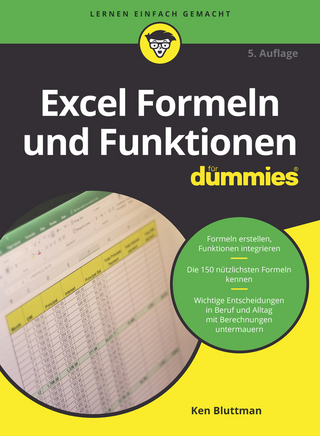
Statistics for Health Care Management and Administration
Jossey-Bass Inc.,U.S. (Verlag)
978-1-119-90167-9 (ISBN)
Statistics for Health Care Management and Administration: Working with Excel introduces the uses of statistics in healthcare management and administration using the features and functions of Microsoft Excel. The book introduces students to statistics within the context of health care, focusing on the major data and analysis techniques used in the field. Step-by-step instructions in the latest version of Excel and numerous annotated screen shots make examples easy to follow and understand.
This updated fourth edition provides the same content and explanations that have made the previous editions so popular, offering revisions drawn directly from universities where the book has been used. All content has been brought current with the newest version of excel, and changes in the field of healthcare administration are covered as well. Statistics for Health Care Management and Administration gets students off to a great start by introducing statistics in the context of their chosen field.
Learn the basics of statistics in the context of Excel
Understand how to acquire data and display it for analysis
Master important concepts and tests, including regression
Turn test results into usable information with proper analysis
This book not only helps students develop the necessary data analysis skills, but also boosts familiarity with important software that employers will be looking for.
David A. Rosenthal is a Chief Information Officer at CampusWorks, Inc. He has over 20 years of health care industry experience in both academic and practitioner settings, having served in roles specific to hospital information technology leadership, multispecialty practice administration, and ambulatory services project management. Rosenthal earned a Master of Public Administration degree from Valdosta State University, and a PhD in Technology Management from Indiana State University. David is a proud veteran of the U.S. Air Force, and resides in Oakland, Tennessee with his wife Allyson. John F. Kros is the Vincent K. McMahon Distinguished Professor in the Marketing and Supply Chain Management Department in the College of Business at East Carolina University, in Greenville, North Carolina. He teaches business decision modeling, statistics, operations and supply chain management, and purchasing and materials management courses. Kros was honored as the College of Business’s Scholar/Teacher for 2004???2005, again in 2009???2010, was awarded the College of Business Commerce Club’s highest honor, the Teaching Excellence Award, for 2006 and again in 2011, in 2013???2014 was awarded the East Carolina Alumni Association Outstanding Teaching Award, and in 2014???2015 was awarded the Board of Governors Distinguished Professor for Teaching Award. Kros earned his PhD in systems engineering from the University of Virginia, his MBA from Santa Clara University, and his BBA from the University of Texas at Austin. His research interests include health care operations, applied statistics, design of experiments, multi-objective decision making, Taguchi methods, and applied decision analysis. His textbook titled Spreadsheet Modeling for Business Decisions is in the fifth edition. He is also coauthor of Health Care Operations and Supply Chain Management.
Preface xiii
Introducing Excel xiii
So How Did We Get to Here? xiii
Intended Level of the Textbook xiv
Textbook Organization xiv
Leading by Example(s) xv
Acknowledgments xvii
The Authors xix
About the Companion Website xxi
Part 1 1
Chapter 1 Statistics and Excel 3
1.1 How This Book Differs from Other Statistics Texts 3
1.2 Statistical Applications in Health Policy and Health Administration 4
Exercises for Section 1.2 14
1.3 What Is the ‘‘Big Picture’’? 15
1.4 Some Initial Definitions 16
Exercises for Section 1.4 26
1.5 Five Statistical Tests 28
Exercises for Section 1.5 30
Chapter 2 Excel as a Statistical Tool 33
2.1 The Basics 33
Exercises for Section 2.1 35
2.2 Working and Moving Around in a Spreadsheet 36
Exercises for Section 2.2 41
2.3 Excel Functions 41
Exercises for Section 2.3 46
2.4 The =IF() Function 47
Exercises for Section 2.4 50
2.5 Excel Graphs 51
Exercises for Section 2.5 56
2.6 Sorting a String of Data 57
Exercise for Section 2.6 60
2.7 The Data Analysis Pack 61
2.8 Functions That Give Results in More than One Cell 63
Exercises for Section 2.8 66
2.9 The Dollar Sign ($) Convention for Cell References 67
Chapter 3 Data Acquisition: Sampling and Data Preparation 71
3.1 The Nature of Data 71
Exercises for Section 3.1 78
3.2 Sampling 79
Exercises for Section 3.2 93
3.3 Data Access and Preparation 94
Exercises for Section 3.3 107
3.4 Missing Data 108
Chapter 4 Data Display: Descriptive Presentation, Excel Graphing Capability 111
4.1 Creating, Displaying, and Understanding Frequency Distributions 111
Exercises for Section 4.1 129
4.2 Using the Pivot Table to Generate Frequencies of Categorical Variables 131
Exercises for Section 4.2 135
4.3 A Logical Extension of the Pivot Table: Two Variables 135
Exercises for Section 4.3 140
Chapter 5 Basic Concepts of Probability 141
5.1 Some Initial Concepts and Definitions 141
Exercises for Section 5.1 150
5.2 Marginal Probabilities, Joint Probabilities, and Conditional Probabilities 150
Exercises for Section 5.2 160
5.3 Binomial Probability 161
Exercises for Section 5.3 171
5.4 The Poisson Distribution 173
Exercises for Section 5.4 178
5.5 The Normal Distribution 178
Chapter 6 Measures of Central Tendency and Dispersion: Data Distributions 183
6.1 Measures of Central Tendency and Dispersion 183
Exercises for Section 6.1 196
6.2 The Distribution of Frequencies 197
Exercises for Section 6.2 208
6.3 The Sampling Distribution of the Mean 209
Exercises for Section 6.3 219
6.4 Mean and Standard Deviation of a Discrete Numerical Variable 220
Exercises for Section 6.4 222
6.5 The Distribution of a Proportion 222
Exercises for Section 6.5 227
6.6 The t Distribution 227
Exercises for Section 6.6 232
Part 2 235
Chapter 7 Confidence Limits and Hypothesis Testing 237
7.1 What Is a Confidence Interval? 237
Exercises for Section 7.1 243
7.2 Calculating Confidence Limits for Multiple Samples 244
Exercises for Section 7.2 246
7.3 What Is Hypothesis Testing? 247
Exercises for Section 7.3 249
7.4 Type I and Type II Errors 250
Exercises for Section 7.4 266
7.5 Selecting Sample Sizes 267
Exercises for Section 7.5 269
Chapter 8 Statistical Tests for Categorical Data 271
8.1 Independence of Two Variables 271
Exercises for Section 8.1 282
8.2 Examples of Chi-Square Analyses 283
Exercises for Section 8.2 289
8.3 Small Expected Values in Cells 290
Exercises for Section 8.3 292
Chapter 9 t Tests for Related and Unrelated Data 295
9.1 What Is a t Test? 295
Exercises for Section 9.1 302
9.2 A t Test for Comparing Two Groups 303
Exercises for Section 9.2 316
9.3 A t Test for Related Data 318
Exercises for Section 9.3 321
Chapter 10 Analysis of Variance 323
10.1 One-Way Analysis of Variance 323
Exercises for Section 10.1 339
10.2 ANOVA for Repeated Measures 340
Exercises for Section 10.2 348
10.3 Factorial Analysis of Variance 349
Exercises for Section 10.3 362
Chapter 11 Simple Linear Regression 365
11.1 Meaning and Calculation of Linear Regression 365
Exercises for Section 11.1 373
11.2 Testing the Hypothesis of Independence 374
Exercises for Section 11.2 380
11.3 The Excel Regression Add-In 381
Exercises for Section 11.3 388
11.4 The Importance of Examining the Scatterplot 388
11.5 The Relationship between Regression and the t Test 391
Exercises for Section 11.5 392
Chapter 12 Multiple Regression: Concepts and Calculation 395
12.1 Introduction 395
Exercises for Section 12.1 406
Chapter 13 Extensions of Multiple Regression 409
13.1 Dummy Variables in Multiple Regression 409
Exercises for Section 13.1 420
13.2 The Best Regression Model 421
Exercises for Section 13.2 431
13.3 Correlation and Multicolinearity 432
Exercises for Section 13.3 435
13.4 Nonlinear Relationships 435
Exercises for Section 13.4 447
Chapter 14 Analysis with a Dichotomous Categorical Dependent Variable 449
14.1 Introduction to the Dichotomous Dependent Variable 450
14.2 An Example with a Dichotomous Dependent Variable: Traditional Treatments 451
Exercises for Section 14.2 462
14.3 Logit for Estimating Dichotomous Dependent Variables 463
Exercises for Section 14.3 475
14.4 A Comparison of Ordinary Least Squares, Weighted Least Squares, and Logit 476
Exercises for Section 14.4 480
Appendix A Multiple Regression and Matrices 481
An Introduction to Matrix Math 481
Addition and Subtraction of Matrices 482
Multiplication of Matrices 483
Matrix Multiplication and Scalars 484
Finding the Determinant of a Matrix 484
Matrix Capabilities of Excel 486
Explanation of Excel Output Displayed with Scientific Notation 489
Using the b Coefficients to Generate Regression Results 490
Calculation of All Multiple Regression Results 491
Exercises for Appendix A 494
References 497
Glossary 499
Index 513
| Erscheinungsdatum | 17.10.2023 |
|---|---|
| Reihe/Serie | Public Health/Epidemiology and Biostatistics |
| Verlagsort | New York |
| Sprache | englisch |
| Maße | 178 x 246 mm |
| Gewicht | 816 g |
| Themenwelt | Informatik ► Office Programme ► Excel |
| Medizin / Pharmazie ► Allgemeines / Lexika | |
| Medizin / Pharmazie ► Gesundheitswesen | |
| ISBN-10 | 1-119-90167-7 / 1119901677 |
| ISBN-13 | 978-1-119-90167-9 / 9781119901679 |
| Zustand | Neuware |
| Haben Sie eine Frage zum Produkt? |
aus dem Bereich


